#grant whytock
Photo
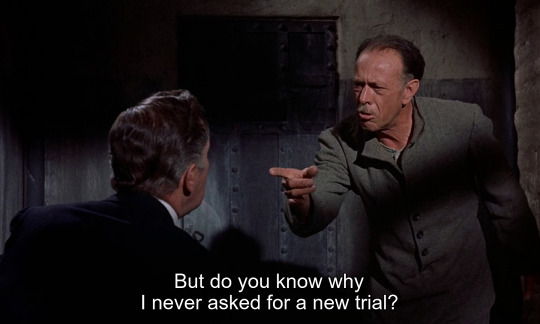




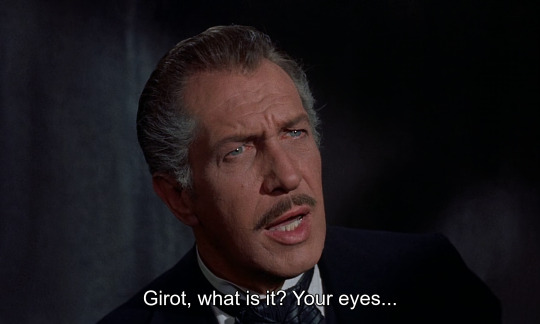




Diary of a Madman (Reginald Le Borg, 1963).
#diary of a madman#diary of a madman (1963)#reginald le borg#vincent price#ellis w. carter#grant whytock#daniel haller#victor a. gangelin#marjorie corso
17 notes
·
View notes
Audio
You'll never see it coming! It's INVISIBLE INVADERS (1959) from producer Robert E. Kent and director Edward L. Cahn!
Starring John Agar, Philip Tonge, John Carradine and Robert Hutton, what moral imperatives will this DAY THE EARTH STOOD STILL-rip off impart?
Context setting 00:00; Synopsis 10:37; Discussion 25:21; Ranking 37:07
#podcast#horror#invisible invaders#1950s sci fi#john carradine#john agar#jean byron#philip tonge#robert kent#edward cahn#samuel newman#the day the earth stood still#1950s#nuclear weapons#maury gertsman#grant whytock#paul dunlap#united artists#b movie#the four skulls of jonathan drake
3 notes
·
View notes
Photo

Ramon Novarro and Alice Terry in Scaramouche (Rex Ingram, 1923)
Cast: Ramon Novarro, Alice Terry, Lewis Stone, Lloyd Ingraham, Julia Swayne Gordon, William Humphrey, Otto Matieson, George Siegmann, Bowditch M. Turner, James A. Marcus, Edith Allen, John George, Willard Lee Hall, Rose Dione. Screenplay: Willis Goldbeck, based on a novel by Rafael Sabatini. Cinematography: John F. Seitz. Art direction: Harold Grieve. Film editing: Grant Whytock.
A year after Ramon Novarro, as Rupert of Hentzau, threatened to steal Rex Ingram's The Count of Monte Cristo away from Lewis Stone's Count, we find the two actors in reversed roles. In Scaramouche Novarro is the dashing hero and Stone the cunning villain. Actually, Scaramouche could have used a bit more dash and cunning in both roles. Novarro isn't given much opportunity to display the impishness he brought to Rupert, even though a title card proclaims, in Rafael Sabatini's words, that Novarro's character, André-Louis Moreau, "was born with the gift of laughter and a sense that the world was mad." Nor does Ingram provide enough swashbuckling for Novarro to do: Most of his duels are fought off camera, and the crucial one with Stone's Marquis de la Tour d'Azyr is somewhat awkwardly staged. Ingram seems to be more interested in Harold Grieve's opulent sets, beautifully filmed by John F. Seitz, and in the menacing crowd scenes of his version of the French Revolution and the Reign of Terror. It's all hokum, of course, but it has its moments.
1 note
·
View note
Text
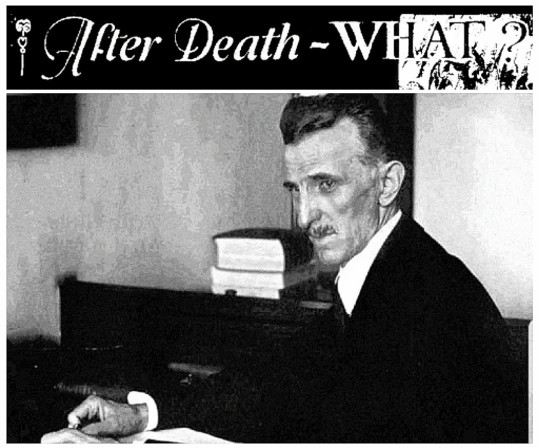
In 1926, Nikola Tesla was asked to share his views on a debate which happened between Luther Burbank, an American botanist and horticulturist, and Henry Ford, founder of the Ford Motor Company, who both shared their beliefs on life after death. Burbank refused to accept the notion that human life continues after death, while Ford firmly believed in reincarnation. Tesla was born into a very religious family, and it was intended that he follow his father in theology and become a priest. It wasn't until he survived cholera that his father allowed him to study science. Tesla maintained his belief in certain principals contained in the Bible, but on the theological side, and to the concept of immortality, he developed his own beliefs. Tesla gave a brief summary about these beliefs on the subject, and seemed to lean more towards Burbank’s stance. Tesla's logic was the reasoning of a practical man of science who has not only given numerous laboratory experiments, but has said to have spent a lifetime of deep mental reflection on the question of life after death.
“Since time immemorial the most profound thinkers have tried to lift the veil that hides the beyond. I have read thousands of volumes of literature and thought for years in the hope that I might get some kind of evidence to show that death is not the end. But all in vain. To me the universe is simply a marvelous mechanism, and the most complex forms of human life, as human beings, are nothing else but automatic engines, controlled by external influence. Through incessant observation I have so convinced myself of the truth of this that I cannot perform any act or even conceive a thought without locating at once the external stimulus that prompted it.
“A forceful argument in support of the existence of a creative agent is made of the law, order and harmony perceptible everywhere. But it must not be forgotten that Kant’s reasoning and conclusion in this respect are irrefutable. According to this philosopher, the conception of fitness has been created in the speculative mind of men, which thus admires a miracle wrought by itself.
“Granted a planetary system, it is absolutely inevitable that in the course of eons such organized beings as we are will evolve. The cooling of the hot masses results in a precipitation of water, and under the influence of the sun’s rays heliotropic action takes place and life is started. Through chemical and other agents and continuous adjustment complex mechanisms come into being, and these ultimately develop into structures of marvelous complexity with capacities of response to the faintest stimulae from the environment.
“When we realize this as a fact we begin to grasp the great idea of Buddha–that self is an illusion. Indeed, we are nothing but waves in space and time which when dissolved exist no more.
“There is this to be said, however, that science without hope is not satisfactory, and unless one has some ideals he cannot achieve happiness. The religious is the most lofty ideal, and it seems that the great reformers who, ages ago, laid down rules of conduct were right in their conclusions that a peaceful existence and a continued onward march of man on this globe is essentially dependent on the conception of a God.
“I have read Mr. Burbank’s statement in which he expresses an opinion shared by most natural philosophers, but one must not be too rash in contradicting the conclusions reached by countless men of genius who spent their lives in endeavors to ascertain the destiny of the human race. A single individual, however well informed and capable, may be partially unaware of if not utterly blind to evidences of a certain kind, which might be quite sufficient for others. This is the reason why I am distrustful of my own findings. Possibly Mr. Ford, who I understand is accepting old traditions, may be closer to the truth than such men as Burbank and myself.
“I have searched during many years for some process or means to test the possibility of future existence by scientific experiment, and I have devised one, which, to my great disappointment, has failed. But perhaps some more skillful experimenter might succeed if I suggest to him the course. To put it briefly, it is this:
“Our bodies are composed of molecules of various elements, harmoniously united. Do these molecules retain any after-effect when the body is dissolved? To ascertain this take, say, two molecules of hydrogen from the body of an individual and also one molecule of oxygen. Furthermore, provide another molecule of oxygen taken from some other body. Now place the two molecules of hydrogen so they can combine with the oxygen, and if they prefer that molecule of oxygen with which they were previously united, then reincarnation is proved. For, though it may take ages and ages, ultimately the molecules which constituted that body will get together again, just as in a vast city individuals from a distant land finally meet and establish close contact.”
–Nikola Tesla
“After Death — WHAT?” By Ross Duff Whytock. Lima News, Lima, Ohio, March 14, 1926.
#nikola tesla#science#history#religion#life and death#philosophy#life after death#reincarnation#quotes#ahead of his time#ahead of our time
66 notes
·
View notes
Text
The Man In The Iron Mask (1939)
The Man In The Iron Mask (1939)
BBBB (out of 5) Loose adaptation of the third volume of Three Musketeers stories by Alexandre Dumas, among which was this tale that toyed with the legend an unknown prisoner in the Bastille that many theorized was the hidden twin brother of Louis XIV. Louis’ father was thrilled that his first-born heir was a son until a second, identical boy was born minutes later, his advisors convincing him to…
View On WordPress
#Alan Hale#Albert Dekker#Alexandre Dumas pere#Bert Roach#Boyd Irwin#D&039;Arcy Corrigan#Doris Kenyon#Dorothy Vaughan#Edward Small#Emmett King#George Bruce#Grant Whytock#Harry Woods#Howard Brooks#James Whale#Joan Bennett#John DuCasse Schulze#Joseph Schildkraut#Lane Chandler#Louis Hayward#Lucien Moraweck#Marion Martin#Miles Mander#Montagu Love#Nigel De Brulier#Peter Cushing#Reginald Barlow#Robert H. Planck#Robert Milasch#Sheila Darcy
0 notes
Text
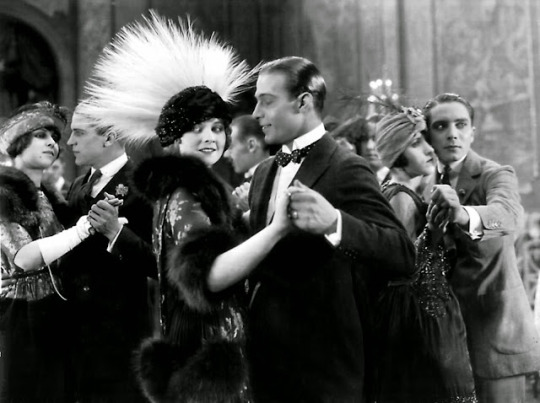
Alice Terry and Rudolph Valentino in The Four Horsemen of the Apocalypse (Rex Ingram, 1921)
Cast: Rudolph Valentino, Alice Terry, Pomeroy Cannon, Josef Swickard, John St. Polis, Alan Hale, Bridgetta Clark, Virginia Warren, Stuart Holmes, Nigel De Brulier, Wallace Beery. Screenplay: June Mathis, based on a novel by Vicente Blasco Ibañez. Cinematography: John F. Seitz. Art direction: Joseph Calder, Amos Myers. Film editing: Grant Whytock.
Nobody reads that whopping bestseller of 1919, Vicente Blasco Ibañez's The Four Horsemen of the Apocalypse, anymore, but Rex Ingram's film version, adapted from the novel and shepherded through production by June Mathis, has helped keep it in print for a century. It's an impassioned reaction to the horror of World War I as well as the film that helped establish Rudolph Valentino -- who was discovered by Mathis -- as a superstar the moment he stepped onto the dance floor with Beatrice Dominguez for a sizzling tango. Granted, some aspects of Valentino's appeal have gone out of style: the flared nostrils and lowered eyelids and the oil-slicked hair that glistens like an LP record. But late in the film, when he appears with a few days' growth of beard, he could vie with any contemporary stubble-enhanced leading man. And he was not an inconsiderable actor, more than holding his own in a company of scenery-chewers. Just standing there, he had the quiet self-assurance of someone like Gary Cooper, an actor who draws the eye without begging for it. There is much that's preposterous about Ibañez's story, especially the mysterious Tchernoff (Nigel De Brulier), who lives in the attic above Julio Desnoyer's (Valentino) studio and descends at the start of the war to deliver a sermon about the four horsemen in the book of Revelation, illustrating it with Dürer's woodcuts. There are some characters and incidents brought over from the novel that could have been cut, like Julio's sister, Chichí (Virginia Warren), and the married couple across the way from Julio's studio, a Frenchman and a German woman. The latter falls to her death from her window after her husband marches off to war, a blatant symbolic moment. But Mathis's adaptation is on the whole solid, and John F. Seitz's cinematography makes the most of the expensive sets.
1 note
·
View note
Photo
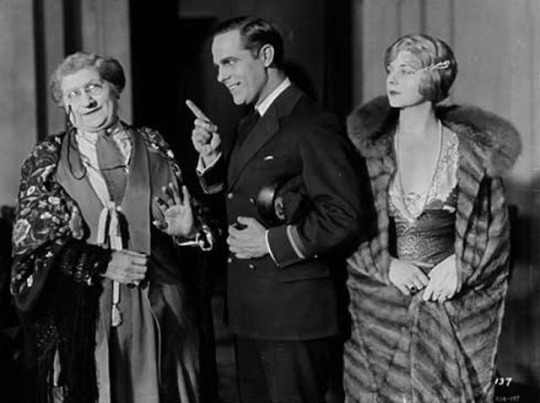
Pâquerette, Antonio Moreno, and Alice Terry in Mare Nostrum (Rex Ingram, 1926)
Cast: Antonio Moreno, Alice Terry, Apollon Uni, Álex Nova, Kada-Abd-el-Kader, Hughie Mack, Mademoiselle Kithnou, Mickey Brantford, Rosita Ramírez, Frédéric Mariotti, Pâquerette, Fernand Mailly, Andrews Engelmann. Screenplay: Willis Goldbeck, based on a novel by Vicente Blasco Ibáñez. Cinematography: John F. Seitz. Art direction: Ben Carré. Film editing: Grant Whytock.
The Spanish novelist Vicente Blasco Ibáñez is known today mostly for melodramatic novels, many of them family sagas that reflect the early influence of Zola's Naturalist explorations of heredity as destiny, which attracted the attention of Hollywood filmmakers: Blood and Sand (Fred Niblo, 1922; Rouben Mamoulian, 1941) and The Four Horsemen of the Apocalypse (Rex Ingram, 1921; Vincente Minnelli, 1962), as well as the ones that were used for Greta Garbo's American debut, Torrent (Monta Bell, 1926) and The Temptress (Niblo, 1926). The Four Horsemen in particular had been such a success, creating the phenomenon of Rudolph Valentino, that it was quite logical for its director, Ingram, to go back to Ibáñez as a source when he launched his European-based production company in 1926. Mare Nostrum was also a vehicle for Ingram's wife, Alice Terry, who had starred opposite Valentino in Horsemen. Unfortunately, he had no Valentino at his disposal this time, and Antonio Moreno, who had just starred with Garbo in The Temptress, is a rather pallid substitute in the lead role of Ulysses Ferragut. Still, Ingram had the advantage of being based on the French Riviera, putting some spectacular locations like Marseille, Naples, Paestum, and Pompeii close at hand. The glimpses of these places in Mare Nostrum during the interim between two World Wars are the most fascinating thing about the film, outweighing the clumsiness of the adaptation, which drags in too much backstory about Ferragut's family history and a few too many secondary characters we don't care about as much as we seem to be urged to do. Terry makes the most of her role as the femme fatale, and there's a great campy bit by the actress known as Pâquerette as the large but sinister German villain.
1 note
·
View note
Photo

Ramon Novarro in The Prisoner of Zenda (Rex Ingram, 1922)
Cast: Lewis Stone, Alice Terry, Robert Edeson, Stuart Holmes, Ramon Novarro, Barbara La Marr, Malcolm McGregor. Screenplay: Mary O'Hara, based on a novel by Anthony Hope. Cinematography: John F. Seitz. Art direction: Amos Myers. Film editing: Grant Whytock.
What Rex Ingram's silent version of the old chestnut The Prisoner of Zenda needs is more Ramon Novarro as Rupert of Hentzau, the impish villain. What there is of Novarro's Rupert is delightful; more than almost any other member of the cast he shows the kind of awareness that the camera sees all, which would take him from silents into the sound era. It was near the start of his career, a year before became a star in Fred Niblo's Ben-Hur, and he's still billed as Ramon Samaniego, so it's possible that Ingram didn't fully see his potential. His Rupert is not quite as charmingly wicked as Douglas Fairbanks Jr.'s in the 1937 John Cromwell version of the Anthony Hope tale, but that's partly because Ingram chooses not to play up the role, putting Rupert amid a cadre of Black Michael's henchmen until the final climactic duel with Rudolf. Lewis Stone plays the two Rudolfs with more reserve and less dash than Ronald Colman did in 1937, and Alice Terry is pretty but rather forgettable as Princess Flavia, a role that Madeleine Carroll brought to life in the sound version. Some spectacular sets make up for the tedium of Ruritanian intrigue that threatens to stifle the film whenever Novarro isn't around.
1 note
·
View note
Audio
From director Edward L. Cahn comes IT! THE TERROR FROM BEYOND SPACE (1958)! Marshall Thompson stars in this photo-ALIEN film about a monster from Mars!
This horror sci-fi also stars Shirley Patterson, Kim Spalding, Dabbs Greer and Ann Doran, with Ray "Crash" Corrigan in his last film role in Paul Blaisdell's last original creature design.
Context setting 00:00; Synopsis 24:53; Discussion 35:47; Ranking 56:00
#podcast#horror#sci fi#it! the terror from beyond space#edward cahn#jerome bixby#robert kent#edward small#marshall thompson#shawn smith#shirley patterson#kim spalding#dabbs greer#ann doran#ray crash corrigan#paul blaisdell#kenneth peach#grant whytock#paul sawtell#united artists#curse of the faceless man#alien#star trek#the martian
6 notes
·
View notes
Audio
After seeing what director Edward L Cahn and his crew could accomplish with last week's film, your deadicated hosts were excited for the second half of their double feature! But does CURSE OF THE FACELESS MAN (1958) meet our expectations??
Inspired by 1932's THE MUMMY, this horror features a Roman gladiator reborn from the destruction of Pompeii! The film stars Richard Anderson, Elain Edwards, Adele Mara, Luis Van Rooten and Bob Bryant.
Context setting 00:00; Synopsis 9:44; Discussion 19:22; Ranking 37:08
#podcast#curse of the faceless man#the mummy#edward cahn#jerome bixby#robert kent#richard anderson#elaine edwards#adele mara#luis van rooten#bob bryant#kenneth peach#grant whytock#gerald fried#vogue productions#united artists#robert e kent productions#pompeii#mount vesuvius#it the terror from beyond space#horror#classic horror
4 notes
·
View notes
Text
Nikola Tesla's Views On Life After Death


Tesla’s reasoning is the reasoning of a practical man of science, who has not only given laboratory tests but deep mental consideration to the question of immortality. There is a deal of the esthetic about Tesla, and as he talks his deep-set eyes seem to be looking into the far distance. Born of a Greek church clergyman, in Smiljan in Serbia, it was intended that the young Tesla follow theology as a profession, but the inventive genius, inherited from his mother, took him into the realm of science. But all his life–he is now 68 years old–he has given deep thought to the question of life after death. He has come to no hasty conclusions, and his remarkable statement might be said to be a brief summarizing of years of thought.
“Since time immemorial the most profound thinkers have tried to lift the veil that hides the beyond. I have read thousands of volumes of literature and thought for years in the hope that I might get some kind of evidence to show that death is not the end. But all in vain. To me the universe is simply a marvelous mechanism, and the most complex forms of human life, as human beings, are nothing else but automatic engines, controlled by external influence. Through incessant observation I have so convinced myself of the truth of this that I cannot perform any act or even conceive a thought without locating at once the external stimulus that prompted it.
“A forceful argument in support of the existence of a creative agent is made of the law, order and harmony perceptible everywhere. But it must not be forgotten that Kant’s reasoning and conclusion in this respect are irrefutable. According to this philosopher, the conception of fitness has been created in the speculative mind of men, which thus admires a miracle wrought by itself.
“Granted a planetary system, it is absolutely inevitable that in the course of eons such organized beings as we are will evolve. The cooling of the hot masses results in a precipitation of water, and under the influence of the sun’s rays heliotropic action takes place and life is started. Through chemical and other agents and continuous adjustment complex mechanisms come into being, and these ultimately develop into structures of marvelous complexity with capacities of response to the faintest stimulae from the environment.
“When we realize this as a fact we begin to grasp the great idea of Buddha–that self is an illusion. Indeed, we are nothing but waves in space and time which when dissolved exist no more.
“There is this to be said, however, that science without hope is not satisfactory, and unless one has some ideals he cannot achieve happiness. The religious is the most lofty ideal, and it seems that the great reformers who, ages ago, laid down rules of conduct were right in their conclusions that a peaceful existence and a continued onward march of man on this globe is essentially dependent on the conception of a God.
“I have read Mr. Burbank’s statement in which he expresses an opinion shared by most natural philosophers, but one must not be too rash in contradicting the conclusions reached by countless men of genius who spent their lives in endeavors to ascertain the destiny of the human race. A single individual, however well informed and capable, may be partially unaware of if not utterly blind to evidences of a certain kind, which might be quite sufficient for others. This is the reason why I am distrustful of my own findings. Possibly Mr. Ford, who I understand is accepting old traditions, may be closer to the truth than such men as Burbank and myself.
“I have searched during many years for some process or means to test the possibility of future existence by scientific experiment, and I have devised one, which, to my great disappointment, has failed. But perhaps some more skillful experimenter might succeed if I suggest to him the course. To put it briefly, it is this:
“Our bodies are composed of molecules of various elements, harmoniously united. Do these molecules retain any after-effect when the body is dissolved? To ascertain this take, say, two molecules of hydrogen from the body of an individual and also one molecule of oxygen. Furthermore, provide another molecule of oxygen taken from some other body. Now place the two molecules of hydrogen so they can combine with the oxygen, and if they prefer that molecule of oxygen with which they were previously united, then reincarnation is proved. For, though it may take ages and ages, ultimately the molecules which constituted that body will get together again, just as in a vast city individuals from a distant land finally meet and establish close contact.”
–Nikola Tesla.
“After Death — WHAT?” By Ross Duff Whytock. Lima News, Lima, Ohio, March 14, 1926.
#Nikola Tesla#science#history#philosophy#life#death#reincarnation#religions#universe#mechanistic theory of life#quotes#ahead of his time#ahead of our time
154 notes
·
View notes
Photo

Tesla’s reasoning is the reasoning of a practical man of science, who has not only given laboratory tests but deep mental consideration to the question of immortality. There is a deal of the esthetic about Tesla, and as he talks his deep-set eyes seem to be looking into the far distance. Born of a Greek church clergyman, in Smiljan in Serbia, it was intended that the young Tesla follow theology as a profession, but the inventive genius, inherited from his mother, took him into the realm of science. But all his life–he is now 68 years old–he has given deep thought to the question of life after death. He has come to no hasty conclusions, and his remarkable statement might be said to be a brief summarizing of years of thought.
“Since time immemorial the most profound thinkers have tried to lift the veil that hides the beyond. I have read thousands of volumes of literature and thought for years in the hope that I might get some kind of evidence to show that death is not the end. But all in vain. To me the universe is simply a marvelous mechanism, and the most complex forms of human life, as human beings, are nothing else but automatic engines, controlled by external influence. Through incessant observation I have so convinced myself of the truth of this that I cannot perform any act or even conceive a thought without locating at once the external stimulus that prompted it.
“A forceful argument in support of the existence of a creative agent is made of the law, order and harmony perceptible everywhere. But it must not be forgotten that Kant’s reasoning and conclusion in this respect are irrefutable. According to this philosopher, the conception of fitness has been created in the speculative mind of men, which thus admires a miracle wrought by itself.
“Granted a planetary system, it is absolutely inevitable that in the course of eons such organized beings as we are will evolve. The cooling of the hot masses results in a precipitation of water, and under the influence of the sun’s rays heliotropic action takes place and life is started. Through chemical and other agents and continuous adjustment complex mechanisms come into being, and these ultimately develop into structures of marvelous complexity with capacities of response to the faintest stimulae from the environment.
“When we realize this as a fact we begin to grasp the great idea of Buddha–that self is an illusion. Indeed, we are nothing but waves in space and time which when dissolved exist no more.
“There is this to be said, however, that science without hope is not satisfactory, and unless one has some ideals he cannot achieve happiness. The religious is the most lofty ideal, and it seems that the great reformers who, ages ago, laid down rules of conduct were right in their conclusions that a peaceful existence and a continued onward march of man on this globe is essentially dependent on the conception of a God.
“I have read Mr. Burbank’s statement in which he expresses an opinion shared by most natural philosophers, but one must not be too rash in contradicting the conclusions reached by countless men of genius who spent their lives in endeavors to ascertain the destiny of the human race. A single individual, however well informed and capable, may be partially unaware of if not utterly blind to evidences of a certain kind, which might be quite sufficient for others. This is the reason why I am distrustful of my own findings. Possibly Mr. Ford, who I understand is accepting old traditions, may be closer to the truth than such men as Burbank and myself.
“I have searched during many years for some process or means to test the possibility of future existence by scientific experiment, and I have devised one, which, to my great disappointment, has failed. But perhaps some more skillful experimenter might succeed if I suggest to him the course. To put it briefly, it is this:
“Our bodies are composed of molecules of various elements, harmoniously united. Do these molecules retain any after-effect when the body is dissolved? To ascertain this take, say, two molecules of hydrogen from the body of an individual and also one molecule of oxygen. Furthermore, provide another molecule of oxygen taken from some other body. Now place the two molecules of hydrogen so they can combine with the oxygen, and if they prefer that molecule of oxygen with which they were previously united, then reincarnation is proved. For, though it may take ages and ages, ultimately the molecules which constituted that body will get together again, just as in a vast city individuals from a distant land finally meet and establish close contact.”
–Nikola Tesla.
By Ross Duff Whytock. “After Death — WHAT?” Lima News, Lima, Ohio, March 14, 1926, Pg. 34.
#Nikola Tesla#quotes#science#history#philosophy#life#death#reincarnation#religion#Immanuel Kant#Buddha#Buddhism#God#atheism#Henry Ford#biology#ahead of his time
70 notes
·
View notes